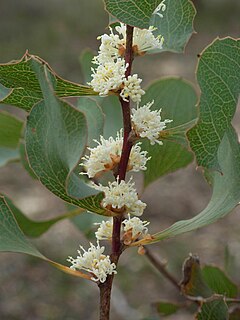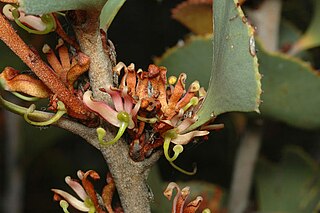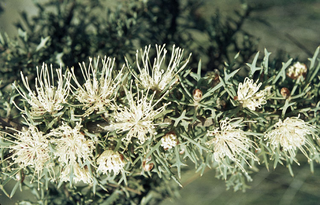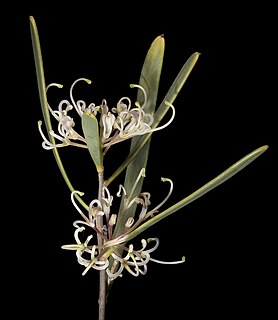
Hakea laurina is shrub or small tree commonly known as kodjet or pin-cushion hakea and is endemic to Western Australia. The Noongar name for the plant is kodjet or kojet. It has red and cream conspicuous globular flowers and lance shaped leaves.

Hakea corymbosa, commonly known as the cauliflower hakea is a plant of the family Proteaceae which is endemic to the south-west of Western Australia. An attractive extremely prickly bush with sweetly scented yellowish flowers. The nectar rich blooms and dense form provides a good habitat for wildlife.

Grevillea crithmifolia is a species of flowering plant in the family Proteaceae and is endemic to the south-west of Western Australia. It is a dense shrub with linear leaves, divided leaves with narrowly oblong lobes, or both, and clusters of pale pink to creamy-white flowers.

Hakea decurrens, commonly known as bushy needlewood, is a species of shrub or small tree in the family Proteaceae.

Hakea lorea, commonly known as bootlace oak or cork tree, is a species of shrub or small tree in the family Proteaceae found in central and northern Australia. It has needle-shape leaves, yellow, white or green flowers and hard corky bark.

Hakea cristata, commonly known as the snail hakea, is a shrub in the family Proteaceae native to Western Australia. An ornamental prickly shrub with attractive foliage and creamy white rounded flowers appearing in profusion in the winter months.

Hakea tephrosperma commonly known as hooked needlewood, is a shrub or small tree species in the family Proteaceae. It has cream flowers, needle-shaped leaves and is one of the taller species adaptable for dry to temperate locations.

Grevillea floribunda, commonly known as seven dwarfs grevillea, is a species of flowering plant in the family Proteaceae and is endemic to eastern Australia. It is a spreading shrub with oblong to egg-shaped leaves with the narrower end towards the base and groups of six to twenty flowers covered with rusty brown hairs.

Hakea eriantha, commonly known as tree hakea, is a shrub or small tree endemic to the east coast of Australia. It has white flowers on a woolly stem in leaf axils, long narrow leaves with reddish new growth. Found growing at higher altitudes in moist or sclerophyll Eucalyptus woodland.

Hakea cucullata, commonly known as hood-leaved hakea, cup hakea or scallop hakea, is a species of shrub in the family Proteaceae and is endemic to the south-west of Western Australia. An attractive shrub with unusual distinctive foliage and beautiful large pink, red or deep purple scented flowers.

Persoonia tenuifolia, commonly known as fine-leaf geebung is a plant in the family Proteaceae and is endemic to eastern Australia. It is an erect to low-lying shrub with hairy young branchlets, linear leaves, and yellow flowers in groups of up to eight on a rachis 2–30 mm (0.079–1.181 in) long that continues to grow after flowering.
Persoonia striata is a species of flowering plant in the family Proteaceae and is endemic to the south-west of Western Australia. It is an erect, often spreading shrub with hairy young branchlets, linear to spatula-shaped leaves, and bright yellow flowers borne in groups of up to five on a rachis up to 2 mm (0.079 in) long that continues to grow after flowering.
Grevillea cunninghamii is a species of flowering plant in the family Proteaceae and is endemic to the north of Western Australia. It is a shrub with egg-shaped leaves with sharply-pointed teeth on the edges, and clusters of red flowers.

Hakea adnata is a shrub in the family Proteaceae native to the south coast of Western Australia. It is multi-stemmed shrub that produces masses of white scented flowers from late winter to spring.

Hakea baxteri, commonly known as fan-leaf hakea , is a shrub in the family Proteaceae native to an area in the Great Southern and Wheatbelt regions of Western Australia. A species noted for its foliage due to its fan-shaped leaves.

Hakea falcata, commonly known as sickle hakea, is a shrub in the family Proteacea and is endemic to southern Western Australia. It has narrow egg-shaped leaves, cream flowers and blooms in spring.

Hakea incrassata, commonly known as marble hakea, is a shrub in the family Proteacea and is endemic to Western Australia.

Hakea lasiocarpha, commonly known as long styled hakea, is a shrub in the family Proteacea and is endemic to Western Australia. It has about 30 whitish flowers in clusters in the upper leaf axils, rigid prickly leaves and a limited distribution.

Hakea stenophylla is a shrub or tree in the family Proteacea, with sweetly scented creamy-white flowers. It is endemic to Western Australia.

Hakea fraseri, is a species of shrub or small tree commonly known as the corkwood oak, is a shrub in the family Proteaceae and is endemic to northern New South Wales. It has furrowed bark, pendulous foliage and creamy-white flowers in spring.




















